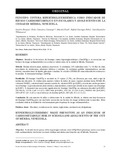Fenotipo cintura hipertrigliceridémica como indicador de riesgo cardiometabólico en escolares y adolescenes de la ciudad de Mérida, Venezuela

View/
Date
2024-04-18Author
Palabras Clave
Obesidad, Circunferencia de cintura, Triglicéridos, Insulina basal, DislipidemiaObesity, Waist circumference, Triglycerides, Basal insulin, Dyslipidemia
Metadata
Show full item recordAbstract
Objetivo: Identificar la frecuencia del fenotipo cintura hipertrigliceridémica (Cint/HTg) y su asociación con
factores de riesgo cardiometabólico en escolares y adolescentes de la ciudad de Mérida, Venezuela.
Método: Estudio observacional, analítico, transversal. Se estudiaron 1292 individuos entre 7 y 18 años de edad,
procedentes de instituciones educativas públicas y privadas. Se evaluaron medidas antropométricas, presión
arterial, concentraciones de lípidos, glucemia e insulina. Se calculó el HOMA-IR como indicador de resistencia a
la insulina. Se determinó fenotipo Cint/HTg.
Resultados: El fenotipo Cint/HTg se encontró en 35 sujetos (2,7%), sin diferencia por sexo, edad o tipo de
institución educativa. Se evidenciaron mayores valores de índice de masa corporal, insulina basal, HOMA-IR,
colesterol NoHDL, colesterol total y menores niveles de colesterol HDL (p=0,0001), en relación con los pacientes
sin el fenotipo. La presión arterial, tanto sistólica como diastólica, estuvo más elevada en los sujetos con el fenotipo
(p<0,005). Se demostró una asociación significativa del fenotipo Cint/HTg con sobrepeso-obesidad (p=0,0001;
OR:166,48; IC95%:22,66-1222,87), cHDL bajo (p=0,0001; OR:7,30; IC:3,64-14,64), cNoHDL alto (p=0,0001;
OR:4,89 IC:2,05-11,65) y con resistencia a la insulina (p=0,01; OR:3,68; IC:1,12-11,21).
Conclusión: En esta muestra de niños y adolescentes de la ciudad de Mérida, se obtuvo una baja frecuencia
del fenotipo Cint/HTg, pero con una fuerte asociación con factores de riesgo cardiovascular reconocidos. Estos
resultados ratifican la utilidad de esta herramienta para despistaje de riesgo cardiometabólico.
Recibido en: agosto 2023 / Aceptado: noviembre 2023
Información Adicional
| Otros Títulos | Hypertriglyceridemic waist phenotype as an indicator of cardiometabolic risk in schools and adolescents of the city of Mérida, Venezuela |
| Correo Electrónico | rvdeme@gmail.com nolispediatra@hotmail.com |
| Editor | SaberULA |
| ISSN | 1690-3110 |
| Resumen en otro Idioma | Objective: To identify the frequency of the hypertriglyceridemic waist (HTg/Waist) phenotype and its association with cardiometabolic risk factors in school children and adolescents from the city of Mérida, Venezuela. Methods: Observational, analytical, cross-sectional study. A total of 1292 individuals between 7 and 18 years of age, from public and private educational institutions, were studied. Anthropometric measurements, blood pressure, and lipid, blood glucose and insulin concentrations were determined. HOMA-IR was determined as an indicator of insulin resistance. The HTg/Waist phenotype was determined. Results: The HTg/Waist phenotype was found in 35 subjects (2.7%), without difference by sex, age or type of educational institution. Higher values of body mass index, basal insulin, HOMA-IR, NoHDL cholesterol, total cholesterol and lower levels of HDL cholesterol were evident (p=0.0001), in relation to patients without the phenotype. Blood pressure, both systolic and diastolic, was higher in subjects with the phenotype (p<0.005). A significant association of the HTg/Waist phenotype was demonstrated with overweight-obesity (p=0.0001; OR:166.48; 95% CI:22.66-1222.87), low HDL-C (p=0.0001; OR: 7.30; CI:3.64-14.64), high NoHDL-C (p=0.0001; OR:4.89 CI:2.05-11.65) and with insulin resistance (p=0. 01; OR:3.68; CI:1.12-11.21). Conclusion: In this sample of children and adolescents from the city of Mérida, a low frequency of the HTg/Waist phenotype was obtained, but with a strong association with recognized cardiovascular risk factors. These results confirm the usefulness of this tool for cardiometabolic risk screening. |
| Colación | 17-24 |
| Periodicidad | Cuatrimestral |
| Página Web | http://www.saber.ula.ve/rvem/ |
| País | Venezuela |
| Institución | Universidad de Los Andes |
| Sección | Revista Venezolana de Endocrinología y Metabolismo: Originales |





